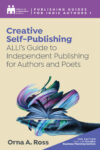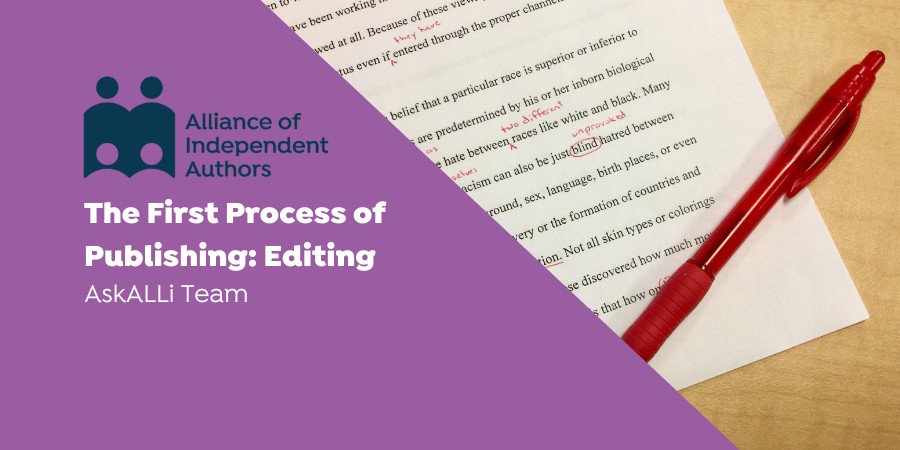In order to bring a book to readers and publish it, you have to follow a series of seven processes. The Alliance of Independent Authors is going to examine these processes in detail. The first process of publishing is editing.
An overview of the seven processes can be found in this post. The rest of the processes can be found here:
ALLi Resources
 The Alliance of Independent Authors also has a number of posts on its blog on editing. If you want to learn more about how to self-edit, then read our Guide to Self-Editing. If you're more interested in fiction editing specifically and story edits, read this post: Editing Fiction.
The Alliance of Independent Authors also has a number of posts on its blog on editing. If you want to learn more about how to self-edit, then read our Guide to Self-Editing. If you're more interested in fiction editing specifically and story edits, read this post: Editing Fiction.
Creative Self-Publishing is a comprehensive guide to every step in the publishing process, written by the director of the Alliance of Independent Authors (ALLi), and drawing on the experience of thousands of ALLi members. The book's focus is how to apply your creativity to publishing, as much as to writing. This book is available for purchase in multiple formats in our bookstore. Members enjoy free access to the ebook by downloading it from our member website. Log in and navigate to PUBLICATIONS > GUIDEBOOKS.
If you're looking for an editor, you can use ALLi's approved partner member directory by logging into the member website and navigating to APPROVED SERVICES.
What is the Editorial Process?
Editorial is the process of turning raw typescript into publishable text. A good book is a large undertaking that requires close attention if we want to put the reader at ease, and ensure our words deliver the impact and influence we seek. The more ambitious your project, and the earlier you are in your development as a writer and publisher, the more editorial work your manuscript will need.
Avoiding the Edit
Good editing is labor-intensive. You can use editing software like ProWritingAid or Grammarly to help, but it still takes human input—often that of several humans, each reading and correcting the full manuscript. This makes it expensive, in terms of time and money, and so beginning self-publishers are inclined to minimize its importance, and give it a skip. More experienced authors too, sometimes.
In third-party publishing, every manuscript is brought through a number of rounds of editing. Experienced authors welcome this process that so improves on their own efforts, knowing there is lots about their book that they don’t see when they’ve just finished, as they are far too close to the words and the sentiments.
There is a movement in certain corners of the indie world that emulates software creators by putting out what’s known as minimally viable product—effectively a raw manuscript that has had little or no editing. Books are not software, best refined by users. Some readers may be forgiving, especially if you’re a talented storyteller or you’re imparting great information or inspiration, but this approach to publishing is bad manners to your readers, marks you out as an amateur and leads to poor reviews that reduce your ratings.
ALLi Recommendations
Ensuring that your book is well edited is vitally important to its success. At ALLi we recommend that every book receives at least two rounds of professional editing: a developmental/copyedit followed by a copyedit/proofread, and ideally these shouldn’t be done by the same person.
The ideal is three rounds: developmental, copyedit, proofread.
Each of these processes is different and even if someone is trained to do both, it’s best to have a fresh pair of eyes during each of these stages.
This does represent an investment upfront, that you may find challenging. You will recoup this, and move into profit, if your book is good and you market it well. If you absolutely can’t afford professional editing, you will need to invest much time and call on your writer friends for help.
Whatever you do, don’t be one of those indies who skip over the editing. ALLi recommends that you hire the best editorial assistance you can afford and that you take great care and a sufficient amount of time to find the right editors and develop a good relationship, work flow and process with them.

Photo by Yannick Pulver on Unsplash
It benefits you both if it can be a long-term relationship, a creative marriage. So choose an editor like you would choose a spouse! And give yourself sufficient time for the editing process, first self-editing, then working with an editor. It’s common among beginner authors to want to get this stage over as quickly as possible to get the book out. This is understandable. It is also a mistake.
When we open ourselves to creative collaboration with beta-readers and editors, we not only greatly improve the book we're currently working on, but we learn a lot and hone creative skills that we can take into the next.
Take the time that’s necessary.
Editing Stages
For author-publishers, editing is a stage in both the writing process and the publishing process. There are three different stages here and it’s important not to confuse them.
- The deepening and development stage of the writing process (redrafting and rewriting your early drafts).
- The correction and clarification stage of the writing process (self-editing your final draft).
- The editing done as part of the publishing process by an editor (professional editing after you’ve done all you can).
All this editorial work is what separates professional authors from the amateurs.
Self-Editing
Rewriting and self-editing are part of your job as a writer, and not substitutes for professional editing. Doing as much self-editing as you can will reduce your editorial bill substantially, however, and must be done to satisfaction before editors will agree to edit your book.
Before you outsource to professional editors, there’s much you can do on your own, perhaps with the help of a book coach or mentor, or with the help of other authors, and your readers too, once you’ve acquired some fans.
The better a manuscript you can deliver to your editor, the more value you will get from the editorial process.
Beta Reading
Beta reading happens when you feel like you’ve done as much self-editing as you possibly can. You then step back from the manuscript and seek feedback from some trusted others (beta-readers).
They offer you their comments, observations and suggestions for improvement, before you send it to your professional editor.
Your beta-readers could be trusted author or publishing friends, or recruited readers, or perhaps family or friends. The main qualifications are that they are well read in your genre. There is not much point giving your YA lesbian mermaid romance to your Booker-prize loving uncle (it happened!). Also, encourage them to give you an honest assessment. This exercise isn’t about self-congratulation or creating an echo chamber, it’s about honest feedback.
You want articulate people, who can convey what they thought clearly, but are not prescriptive and who focus on the big picture. In fiction, this might be major issues around plot, character, pacing and voice. In nonfiction the feedback might be about argument, structure and voice. You don’t, at beta-reader stage, need detailed feedback about word choice and sentence structure. That comes later, from the professional editor(s).
How many beta-readers do you need? As many as you can get. The wider the range of opinions you receive, the better.
Beta Reading Step by Step
Give your betas a tidy manuscript, with as few errors as possible.
Be specific about the kind of advice/opinion you want. Brief them about particular issues that are troubling you. (“Does the argument hold together, did I lose it in the middle?” “Do you find the protagonist sympathetic, or just pathetic?”)
If you are sourcing beta-readers from the internet you can recruit them via your blog, social media or even create a mailing list. You can also find beta-readers by putting out a request in the ALLi private members forum on Facebook.
- Provide each beta-reader with a copy of your manuscript in their preferred format. If there’s something particular you’d like a reader to comment on, be sure to ask, but this isn’t essential.
- Set a deadline for your beta-reading to be completed by; two weeks is a good ball-park.
- Wait until you have all the replies in and sit down to read them all together.
- If you find yourself feeling closed, step back and observe your own resistance. It’s a defense mechanism, your mind and body trying to protect you from a perceived attack. Take a moment to center yourself and clear your mind by following your breath—then remind yourself that you are using this feedback to learn and grow as a writer and publisher. Observe until you can consciously see those defensive thoughts and feelings as they rise and leave you. Use this awareness as a tool to consciously open back up to learning and growth.
- Remember you are the creative director of this book. You won’t be taking on board every single comment. Discard any outlier opinions or those that seem wrong to you. What you’re looking for is clues as to how “most people” would rate your book. If the majority, or a significant minority, of your readers hone in on one facet of your book, that’s what you want to focus on for revision.
- Incorporate desirable changes into your next pass.
- Send a thank-you to all your beta-readers, include them in your acknowledgements page and send them a copy of the book when it is published.
Beta-readers are not a substitute for professional editing. However well-intentioned or perceptive they are, they bring biases. Perhaps they dislike happy endings, or dark humor, or screwball comedy, and those are the very qualities on which you pride yourself. Professional editors are objective, by training, by professional development, and by experience, repeatedly working with a huge variety of books and authors.
Professional Editing
Once the beta phase is over, your book is no doubt better than it was. Now it’s time to bring in the professionals and make it really shine.
Types of Edit
Developmental editing
This involves evaluating the book with specific focus on coherence, structure and tone. A good developmental editor will pay particular attention to what the book is trying to convey and how best to relay that within the confines of the author’s writing style and genre.
A good developmental editor will evaluate:
Fiction and Narrative Nonfiction
- Character Development
- Plot
- Settings
- Story flow and pacing
- Scene openings and scene endings
- Climactic satisfaction and denouement
Practical Nonfiction
- Tone of voice
- Overall coherence
- Inconsistencies in logic and arguments
- Ambiguous or underdeveloped logic or arguments
- Climactic explanation or conclusion
- Further reading and resources
All:
- Structure and balance
- Flow and pace
- Story—overall arc and subplot arcs for fiction. Storytelling use and relevance in nonfiction and poetry
- Word choices
- Inconsistencies
- Unwarranted repetition
- Optimal word count—for the genre, and per chapter and per scene (fiction), per point (nonfiction), and per stanza (poetry)
This sort of edit works at the level of the whole book. It identifies structural and story issues and mistakes, and offers a variety of solutions, developing and refining your voice and style choices, ensuring you have said what you meant to say fully and completely and that the overall book is in balance.
When you receive your feedback, evaluate it before you get to work. Use your discretion, as creative director, to discern which you’ll address and which you’ll ignore. If you disagree with a development note, sit with it before dismissing it outright. More often than not, there may be a grain of truth in the editor’s response, even if the suggestion is not ideal.
Whether for fiction or nonfiction, developmental editing is a deeply creative process and at the end of it you should feel you’ve been given a range of suggestions that help improve the story or the information you’re trying to convey.
Developmental editing takes time and, depending on the condition of the manuscript, and the experience of the author, can take anywhere from a few weeks to many months to complete.
Copyediting
Once your manuscript content is in good shape, the next editorial level is the copyedit. A copyeditor broadly works at the paragraph level and copyediting is the process of making the text flow well from sentence to sentence to eliminate little errors that can trip a reader up and pull them out of your carefully constructed world or argument.
Precisely what is covered by copyediting varies from editor to editor, but you should expect them to check for:
- Unclear, repeated or confusing passages, including use of jargon
- Clichés or stale phrasing
- Over or under description or explication
- Repeated sentences or words
- Run-on sentences
- Passive or weak sentence structure
- In stories, telling versus showing. In nonfiction, preaching or lecturing instead of examples or exercises
- Too many, or unnecessary, adverbs or adjectives
- Stylistic mistakes, e.g. purple prose, or too many sentences or paragraphs structured in similar ways, inappropriate vocabulary, tense shifts
- Inconsistent spellings (US versus Canada versus UK)
- Inconsistent hyphens, punctuation or capitalization
- Language errors including punctuation, grammar and spelling
The copyeditor also ensures your manuscript is internally consistent and accurate. They will watch for mistakes and factual errors and will ask you questions about your intention and meaning. In a novel, a copyeditor might comment on the narrative pacing and point out inconsistencies in character motivation, description, story facts and setting.
A copyeditor will also watch for linguistic issues like odd phrasing, faulty parallelisms, point of view issues and clumsy use of alliteration, metaphor or similes. This latter type of editing is a subset of copyediting called line-editing (or sometimes “stylistic editing”).
A soft copyedit focuses on these objective changes, whereas a hard copyedit also includes more subjective issues like the use of filter words in close point of view, or the use of too many adverbs, or over-elaborate dialog tags.
However, a copyedit is not a detailed proofread, as the manuscript at this stage is still not finally set. You might be left with many questions to answer, so allow time for this.
Proofreading
The last phase in the editing process involves checking again for errors in spelling or punctuation, typos, repeated words and other human slips, such as copy/paste mistakes. It’s also the very last look at your typescript before it goes into the production process. If headings and subheadings are used, these will be checked for consistency.
Proofreading is about presentation, not subject matter. Mistakes like a character having blue eyes in chapter one and brown eyes in chapter twenty should have been picked up in copyediting, but this is the last chance to pick up errors that might have been missed, or even introduced, at earlier stages.
Hiring an Editor
Choose an editor who has experience in your genre or specializes in your book topic. Don’t pick a travel editor for your romance book.
Also, find out what others have said about their work. Get a list of work they’ve edited before and check it out. Check their LinkedIn and checked out the works they’ve edited along with any reviews.
Evaluate any testimonials; talk directly to the author, do not take comments on an editor’s website at face value.
Next, ask them to do a sample edit of your manuscript. Most editors will do a sample edit on a few pages so you can get sense of their approach. The relationship is also important. Do a face-to-face interview, on an online video call or in person.
When you get your manuscript back from the editor, it will generally be in MS Word with track changes enabled, so you can see the work they’ve done. Make sure to check over the errors they spotted. It’s a great way to learn the mistakes that you most regularly make so you can improve upon them next time.
Address all the notes they’ve made. Delve back into your draft and implement as much or as little of the suggestions as necessary. Use your discretion, as creative director, to discern which of the notes you’ll address and which to ignore or adapt.
If you disagree with a development note, sit with it before dismissing it. Even if you don’t agree with their verdict or solution, if they’ve noticed a problem with something it probably needs more attention from you.
Costs and Comeback
Because each editing job is unique it’s impossible to say in advance what an editing job will cost. Editors can give an indicative range of pricing, a per word or per hour rate, but they’ll need to see a sample to give an exact quote.
ALLi partner members are required to give such indicative pricing on their websites. You can also find price ranges from the Chartered Institute of Editors and Proofreaders and ALLi Partner Member Reedsy.com.
If you feel a beta-reader or editor has let you down, or been unprofessional, don’t rant and argue and tell them they’re idiots who know nothing about writing. Say thank you for the feedback or the work, and quietly drop them off your list.
Every edit is a learning opportunity but it can be hard to hear feedback, especially when we’re starting out. Never take it personally, and never get personal about it. It’s an opinion about your book, not about you.
ALLi Member Case Studies

Michael Webb, Authorpreneur member
Michael Webb, authorpreneur member
Can you outline your self-editing process, what does it look like? How long does it take? Do you use any software to help you?
First, I’ll do a slow read through on my own, looking for mistakes, grammar problems, but a lot of it is rewriting sentences for better flow and readability (catching overused words, awkward dialog tags, awkward internal monologue, stuff like that). Then, I run it through ProWritingAid to catch more.
Then, I copy to Google Docs (in chunks of 25k words of so, so it doesn’t overwork the system) and I use the free Grammarly that’s built into Google Docs. Also, during this time, I brainstorm about big picture issues (character arcs, hero/villain relationship, plot arc, etc) thinking about if there’s anything missing.
For a 100k word book, I’ll usually spend about 25-30 hours on this.
How do you process your editors feedback and how do you integrate it?
When I get editor feedback, first, I read through big picture feedback. Those are the items that will take more work to update in the book. I don’t make those changes yet, but I internalize them, so when I dive into the book, I’m keeping them in mind.
Then, I jump into the detail corrections. These are the line edits, rewording, punctuation changes, etc. I read every one of them. I use it as a learning process (“What did they change? Why did they change it? Do I agree with the change?”) This helps my future writing get better.
Then, I work through the whole manuscript addressing each change. Then, I’ll go back to the big-picture notes and see if I addressed them all. If needed, I’ll dive in and make sure updates if there’s a point I didn’t fully address yet.
You no longer use dev editors, are you using beta/critique partners instead?
I used a dev editor for my first 5 books, but I feel more confident about my ability to construct a quality story now. So, I HEAVILY rely on beta readers. These are sometimes fans, but several are writers themselves. I ask them to look for anything (plot holes, character issues, awkward sections, overused sentences, confusing parts, etc). When I get feedback (like with my editors) I evaluated each piece of feedback and decide whether or not I agree with it.
Michael Webb is a YA epic fantasy author. You can find out more about him on his website, Facebook and Instagram.

J.R. Thorn also known as A.J. Flowers
JR Thorn, authorpreneur member
Do you have a full-time editor on staff?
I utilize editors who edit full-time but have other clients. I have 2 main editors and 2 backups. I'll split my answer into three parts, prefaced with saying I do not have a developmental editor. These are line editors.
For complex novels and longer series, I use a 0.015c/word editor. She is very educated and skilled. She will do multiple sweeps for grammar, prose, and story consistency/conflicts.
For less complex novels or short stories, I use a 0.005c/word editor. She is a typo-finder. I have a couple of these types of editors if one is busy.
For Amazon Vella episodes when they're first published, I self-edit and use Grammarly. My Vella stories have earned me over $43,000 in Vella bonuses and I have never received complaints or negative reviews for editing, so it has not harmed me doing it that way. But I recognize I'm an experienced author with over 30 books in my backlog, so that likely plays into my ability to self-edit.
Do you have a consistent production schedule and prebooked dates?
Yes and no. I utilize preorders, but often find myself delaying or even canceling. I write full-time, but being creative on a schedule is difficult. I'll let you know when I figure out a consistent production schedule!
How has the way you worked with editors changed since you first started writing?
I used to think I needed to spend thousands on developmental editing. After spending over $5,000 on editing for a series that completely flopped, I revisited that mindset. I only utilize line edits now.
Do you employ street teams or ARC readers to help proof?
I do not employ street teams. I prefer to boost my releases using paid advertising. I have ARC readers, but I do not use them to help proof. From my experience, they do not generally have the right eye to find typos.
JR Thorn writes steamy “why choose” romance. You can find out more about JR on her website.





I have learned many interesting things through your posts. Editing is an important step for me.
This post has been great validation. Thanks ALLi!
I loved the details about picking beta readers – I certainly find that difficult with my genre.
I’m interested in where to slot in sensitivity readers. An ALLi panel suggested to do so early. Would the BETA reader stage be the best place or after the pro dev?
I stay in my lane, but my fiction travel hops around the world as my MC is mixed up in world energy.
I am terrible at predicting how long editing takes for a piece of my work. A friend recommended not arranging edit until a piece is pro-ready. This is a long tail, but it has recently started to pay off and timing my work has become easier. Yay!
If I could time travel back to my start as a writer, I’d suggest going for paid pro advice first because my genre is not so easy to find help with. Reedsy has been a fantastic choice for me.